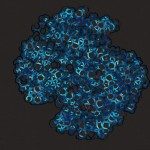Link to Pubmed [PMID] – 16707690
J. Bacteriol. 2006 Jun;188(11):3983-94
In Salmonella enterica serovar Typhimurium, the stationary-phase sigma factor sigma(S) (RpoS) is required for virulence, stress resistance, biofilm formation, and development of the rdar morphotype. This morphotype is a multicellular behavior characterized by expression of the adhesive extracellular matrix components cellulose and curli fimbriae. The Crl protein of Escherichia coli interacts with sigma(S) and activates expression of sigma(S)-regulated genes, such as the csgBAC operon encoding the subunit of the curli proteins, by an unknown mechanism. Here, we showed using in vivo and in vitro experiments that the Crl protein of Salmonella serovar Typhimurium is required for development of a typical rdar morphotype and for maximal expression of the csgD, csgB, adrA, and bcsA genes, which are involved in curli and cellulose biosynthesis. In vitro transcription assays and potassium permanganate reactivity experiments with purified His(6)-Crl showed that Crl directly activated sigma(S)-dependent transcription initiation at the csgD and adrA promoters. We observed no effect of Crl on sigma(70)-dependent transcription. Crl protein levels increased during the late exponential and stationary growth phases in Luria-Beratani medium without NaCl at 28 degrees C. We obtained complementation of the crl mutation by increasing sigma(S) levels. This suggests that Crl has a major physiological impact at low concentrations of sigma(S).



